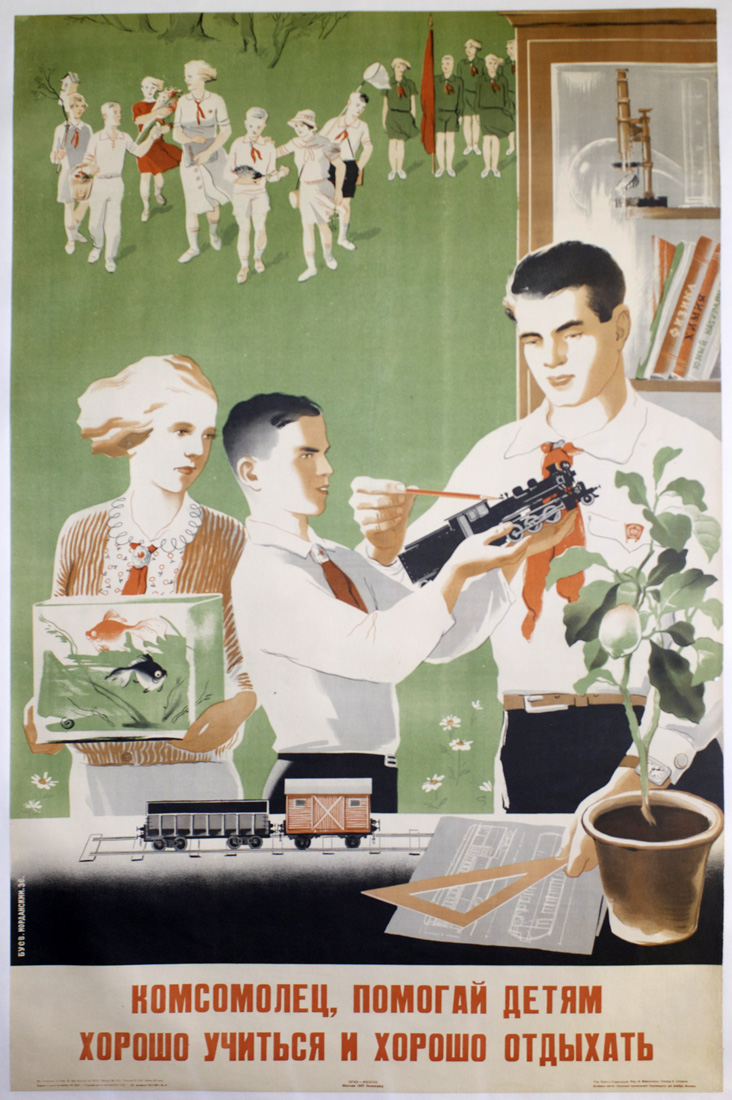
Komsomol member, help children study and play well
Poster Number: PP 327
Category: Youth
Poster Notes: The Komsomol was the All-Union Leninist Young Communist League. It was first called the Russian Young Communist League (RKSM) but with the unification of the U.S.S.R., it was made an all-union organization and youth division of the All-Union Communist Party. Komsomol was the final tier of the three youth organizations in the U.S.S.R. Members were between the ages 14 to 28 and they joined after graduating from the Young Pioneers. Prior to being Pioneers, they graduated at age 9 from the Octobrists.
Media Size: 45x31
Poster Type: Lithograph and Offset
Publishing Date: 1937
Editorial Information: Editor I. Mikhal’skaia. Technical Editor Y. Strukov.
Technical Information on Poster: Izogiz No. 8697. Publication 34. Order No. 1131. Submitted for production January 7, 1937. Approved for printing April 15, 1937. Volume 1 sheet of paper. Price 80 kopeks.
Print Run: 50,000
Glavlit Directory Number: B-7095.
Catalog Notes: PP 327 Youth
Artist: Buev, Ivan Petrovich — Буев, Иван Петрович
Ivan Buev is chiefly known as a painter and a graphic artist and yet he also worked in the monumental and applied art fields. During the 1920s, he studied at VKhUTEIN (Higher State Artistic and Technical Institute), Moscow. In partnership with Boris Iordanskii, Buev worked on the Soviet pavilion for the International Exposition of Art and Technology in Modern Life in Paris (Paris Expo) held from 1936-1937. During the 1930s, Buev was engaged in the ...
Read More About This Artist
Printer: Krasnii Proletarii (Red Proletarian), Moscow — Красный Пролетарий, Москва
The Krasnii Proletarii Workshop originated under the ownership of Ivan Kushnerev, a Russian entrepreneur who founded the Kushnerev & Company Printing Shop in 1869 in Moscow. When Kushnerev died in 1896, his printing operation was one of the largest in Imperial Russia. In 1919, the printer was nationalized by the Soviets and consigned to the Printing Section of the Moscow Economic Council (MSNKh). Around 1920, it was placed under the Poligrafkiniga (Book and Magazine Printing) Trust and was given ...
Read More About This Printer
Publisher: Ogiz-IzoGiz, Moscow — Огиз-Изогиз, Москва
Ogiz was the Association of the State Book and Magazine Publishers. Its main offices were located in Moscow and in Leningrad. The Sovnarkom of the Russian Socialist Federative Soviet Republic established Ogiz in 1930 to centralize publishing activities under a state monopoly in order to eliminate duplication of printed material, streamline and control publishing production and output, and to create a base for marketing books, training and technical manuals. In 1931, the Central Committee of the USSR ...
Read More About This Publisher